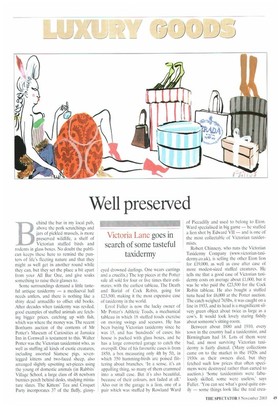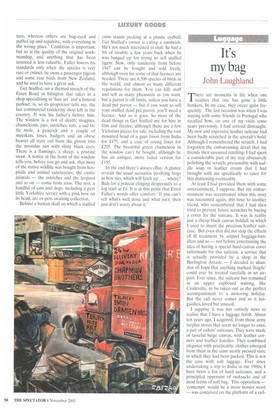Well preserved
Victoria Lane goes in search of some tasteful taxidermy
ehind the bar in my local pub, above the pork scratchings and jars of pickled mussels, is more preserved wildlife, a shelf of Victorian stuffed birds and rodents in glass boxes. No doubt the publican keeps these here to remind the punters of life's fleeting nature and that they might as well get in another round while they can, but they set the place a bit apart from your All Bar One, and give soaks something to raise their glasses to.
Some surroundings demand a little tasteful antique taxidermy — a mediaeval hall needs antlers, and there is nothing like a shiny dead armadillo to offset old books, After decades when taxidermy was reviled, good examples of stuffed animals are fetching bigger prices, catching up with fish, which was where the money was. The recent Bonharns auction of the contents of Mr Potter's Museum of Curiosities at Jamaica Inn in Cornwall is testament to this. Walter Potter was the Victorian taxidermist who, as well as stuffing all kinds of exotic creatures, including assorted Siamese pigs, sevenlegged kittens and two-faced sheep, also arranged slightly upsetting set-pieces using the young of domestic animals (in Rabbits' Village School, a large class of 48 newborn bunnies perch behind desks, studying miniature slates. The Kittens' Tea and Croquet Party incorporates 37 of the fluffy, glassy eyed drowned darlings. One wears earrings and a crucifix.) The top pieces at the Potter sale all sold for four or five times their estimates, with the earliest tableau, The Death and Burial of Cock Robin, going for £23,500, making it the most expensive case of taxidermy in the world.
Errol Fuller is now the lucky owner of Mr Potter's Athletic Toads, a mechanical tableau in which 18 stuffed toads exercise on moving swings and seesaws. He has been buying Victorian taxidermy since he was 15, and has 'hundreds' of cases; his house is packed with glass boxes, and he has a large converted garage to catch the overspill. One of his favourite cases is from 1850, a box measuring only 4ft by 5ft, in which 350 humming-birds are poised flittering about branches. 'In a sense, it's an appalling thing, so many of them crammed into a small case. But it's also beautiful, because of their colours, not faded at all.' Also out in the garage is a lion, one of a pair which was stuffed by Rowland Ward of Piccadilly and used to belong to Eton. Ward specialised in big game — he stuffed a lion shot by Edward VII — and is one of the most collectable of Victorian taxidermists.
Robert Chinnery, who runs the Victorian Taxidermy Company (www.victorian-taxidermy.co.uk), is selling the other Eton lion for £19,000, as well as case after case of more modest-sized stuffed creatures. He tells me that a good case of Victorian taxidermy costs on average about £1,000, but it was he who paid the £23,500 for the Cock Robin tableau. He also bought a stuffed tuna head for £6,000 at the Potter auction. The catch weighed 7651bs, it was caught on a line in 1933, and its head is a magnificent silvery green object about twice as large as a cow's. It would look lovely staring fishily about someone's sitting-room.
Between about 1880 and 1910, every town in the country had a taxidermist, and Birmingham had 18. Lots of them were bad, and most surviving Victorian taxidermy is fairly dismal. (Many collections came on to the market in the 1920s and 1930s as their owners died, but they fetched such low prices that often specimens were destroyed rather than carted to auction.) 'Some taxidermists were fabulously skilled, some were useless,' says Fuller. You can see what's good quite easily — some things look like the real crea ture, whereas others are bug-eyed and puffed up and repulsive, with everything in the wrong place.' Condition is important, but so is the quality of the original workmanship, and anything that has been restored is less valuable. Fuller lowers his standards only when the species is very rare or extinct; he owns a passenger pigeon and some rare birds from New Zealand, and he used to have a great auk.
Get Stuffed, on a themed stretch of the Essex Road in Islington that takes in a shop specialising in 'hair art' and a funeral parlour, is, so its proprietor tells me, the last commercial taxidermy shop left in the country. It was his father's before him. The window is a riot of death: magpies, chameleons, jays, ostriches, rats, a sad little mole, a peacock and a couple of meerkats, foxes, badgers and an obese beaver all stare out from the gloom into the noonday sun with shiny black eyes. There is a flamingo, a sheep, a pristine swan. A notice in the front of the window tells you, before you go and ask, that most of the native wildlife was bought from hospitals and animal sanctuaries; the exotic animals — the ostriches and the leopard and so on — come from zoos. The rest, a handful of cats and dogs, including a pert little Yorkshire terrier with a pink bow on its head, are ex-pets awaiting collection. Behind a human skull on which a stuffed crow stands pecking at a plastic eyeball, Get Stuffed's owner is eating a sandwich. He's not much interested in chat; he had a bit of trouble a few years back when he was banged up for trying to sell stuffed tigers. Now, only taxidermy from before 1947 can be bought and sold freely, although even for some of that licences are needed. There are 8.500 species of birds in the world, and almost as many different regulations for them. You can kill, stuff and sell as many pheasants as you want, but a parrot is off limits, unless you have a dead pet parrot — but if you want to sell your stuffed dead pet parrot, you'll need a licence. And so it goes. So most of the dead things in Get Stuffed are for hire in film and theatre, although there are a few Victorian pieces for sale, including the vast mounted head of a gaur bison from India for £475, and a case of young foxes for £295. The beautiful green chameleon in the window can't be bought, although he has an antique, more faded version for £195.
In the end there's always eBay. A glance reveals the usual scenarios involving frogs in bow ties, which will fetch up . . . where? Bids for a polecat clinging desperately to a log start at £4. It is at this point that Errol Fuller's words offer comfort: 'If you can't tell what's well done and what isn't, then just don't worry about it.'



































































































 Previous page
Previous page